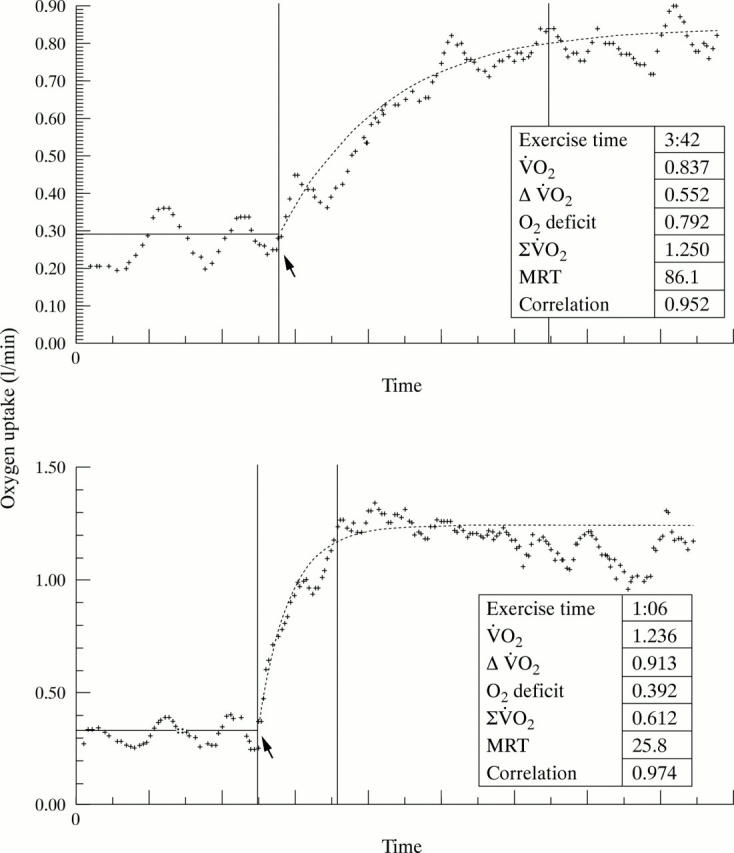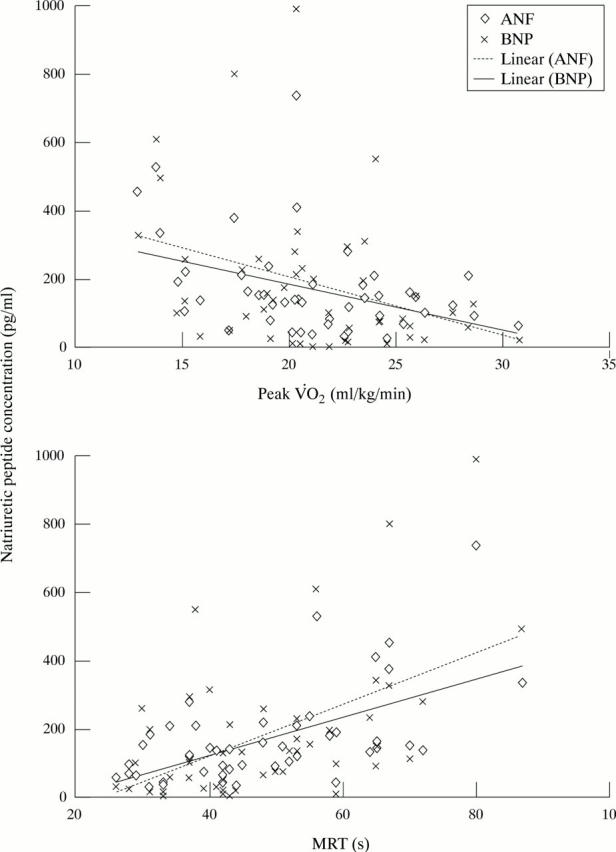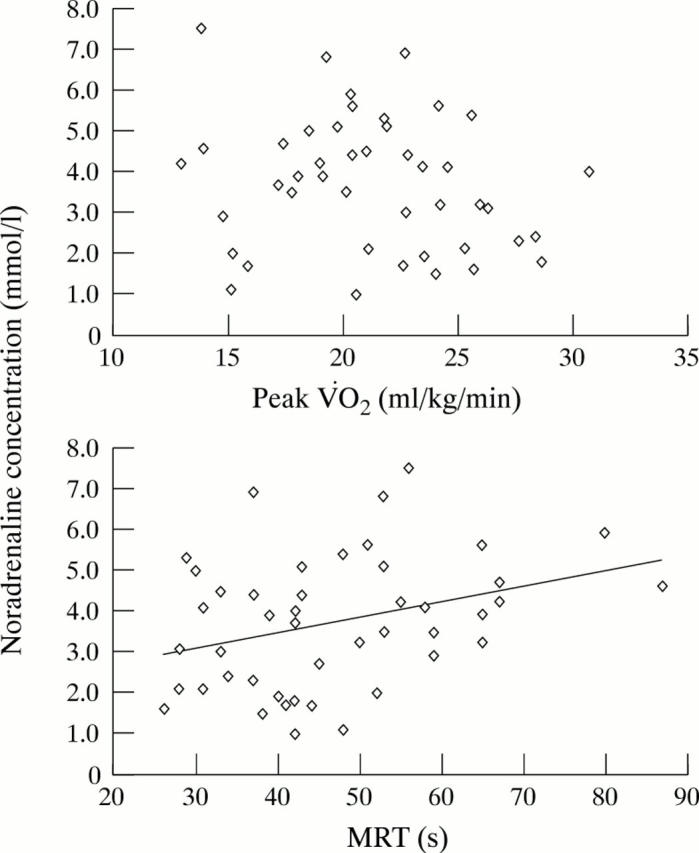Abstract
Objective—To investigate whether oxygen uptake (V̇O2) kinetics during low intensity exercise are related to clinical signs, symptoms, and neurohumoral activation independently of peak oxygen consumption in chronic heart failure. Design—Comparison of V̇O2 kinetics with peak V̇O2, neurohormones, and clinical signs of chronic heart failure. Setting—Tertiary care centre. Patients—48 patients with mild to moderate chronic heart failure. Interventions—Treadmill exercise testing with "breath by breath" gas exchange monitoring. Measurement of atrial natriuretic factor (ANF), brain natriuretic peptide (BNP), and noradrenaline. Assessment of clinical findings by questionnaire. Main outcome measures—O2 kinetics were defined as O2 deficit (time [rest to steady state] × ΔV̇O2 − ∑V̇O2 [rest to steady state]; normalised to body weight) and mean response time of oxygen consumption (MRT; O2 deficit/ΔV̇O2). Results—V̇O2 kinetics were weakly to moderately correlated to the peak V̇O2 (O2 deficit, r = −0.37, p < 0.05; MRT, r = −0.49, p < 0.001). Natriuretic peptides were more closely correlated with MRT (ANF, r = 0.58; BNP, r = 0.53, p < 0.001) than with O2 deficit (ANF, r = 0.48, p = 0.001; BNP, r = 0.37, p < 0.01) or peak V̇O2 (ANF, r = −0.40; BNP, r = −0.31, p < 0.05). Noradrenaline was correlated with MRT (r = 0.33, p < 0.05) and O2 deficit (r = 0.39, p < 0.01) but not with peak V̇O2 (r = −0.20, NS). Symptoms of chronic heart failure were correlated with all indices of oxygen consumption (MRT, r = 0.47, p < 0.01; O2 deficit, r = 0.39, p < 0.01; peak V̇O2, r = −0.48, p < 0.01). Multivariate analysis showed that the correlation of V̇O2 kinetics with neurohormones and symptoms of chronic heart failure was independent of peak V̇O2 and other variables. Conclusions—Oxygen kinetics during low intensity exercise may provide additional information over peak V̇O2 in patients with chronic heart failure, given the better correlation with neurohormones which represent an index of homeostasis of the cardiovascular system. Keywords: oxygen consumption; low intensity exercise; heart failure; neurohormones
Full Text
The Full Text of this article is available as a PDF (166.4 KB).
Figure 1 .

Patient with delayed (upper panel) and normal (lower panel) oxygen uptake (V̇O2 ) kinetics at exercise onset. First vertical line (arrow) indicates onset of exercise and the second vertical line the time to steady state.
Figure 2 .

Scatterplot of peak oxygen consumption (V̇O2) (upper panel) and mean response time (MRT) of oxygen consumption at exercise onset to natriuretic peptides. The correlation of MRT to natriuretic peptides was closer (ANF, r = 0.59; BNP, r =0.53; p < 0.001) than the correlation of peak V̇O2 (ANF, r = −0.40, p < 0.01; BNP, r = −0.31, p < 0.05).
Figure 3 .

Scatterplot of peak oxygen consumption (V̇O2) (upper panel) and mean response time (MRT) of oxygen consumption at exercise onset to noradrenaline. Only the correlation of MRT with noradrenaline was significant (r = 0.33; p < 0.05; peak V̇O2, r = −0.20, NS).
Selected References
These references are in PubMed. This may not be the complete list of references from this article.
- Aaronson K. D., Schwartz J. S., Chen T. M., Wong K. L., Goin J. E., Mancini D. M. Development and prospective validation of a clinical index to predict survival in ambulatory patients referred for cardiac transplant evaluation. Circulation. 1997 Jun 17;95(12):2660–2667. doi: 10.1161/01.cir.95.12.2660. [DOI] [PubMed] [Google Scholar]
- Bauch H. J., Kelsch U., Hauss W. H. Einfache, schnelle, selektive und quantitative Bestimmung von Adrenalin und Noradrenalin im Plasma durch Kombination von Flüssigextraktion, HPLC-Trennung und elektrochemischer Detektion. J Clin Chem Clin Biochem. 1986 Sep;24(9):651–658. [PubMed] [Google Scholar]
- Benedict C. R., Shelton B., Johnstone D. E., Francis G., Greenberg B., Konstam M., Probstfield J. L., Yusuf S. Prognostic significance of plasma norepinephrine in patients with asymptomatic left ventricular dysfunction. SOLVD Investigators. Circulation. 1996 Aug 15;94(4):690–697. doi: 10.1161/01.cir.94.4.690. [DOI] [PubMed] [Google Scholar]
- Bittner V., Weiner D. H., Yusuf S., Rogers W. J., McIntyre K. M., Bangdiwala S. I., Kronenberg M. W., Kostis J. B., Kohn R. M., Guillotte M. Prediction of mortality and morbidity with a 6-minute walk test in patients with left ventricular dysfunction. SOLVD Investigators. JAMA. 1993 Oct 13;270(14):1702–1707. [PubMed] [Google Scholar]
- Cahalin L. P., Mathier M. A., Semigran M. J., Dec G. W., DiSalvo T. G. The six-minute walk test predicts peak oxygen uptake and survival in patients with advanced heart failure. Chest. 1996 Aug;110(2):325–332. doi: 10.1378/chest.110.2.325. [DOI] [PubMed] [Google Scholar]
- Chelimsky-Fallick C., Stevenson L. W., Lem V., Whipp B. J. Excessive oxygen deficit during low-level exercise in heart failure. Am J Cardiol. 1995 Oct 15;76(11):799–802. doi: 10.1016/s0002-9149(99)80230-6. [DOI] [PubMed] [Google Scholar]
- Cross A. M., Jr, Higginbotham M. B. Oxygen deficit during exercise testing in heart failure. Relation to submaximal exercise tolerance. Chest. 1995 Apr;107(4):904–908. doi: 10.1378/chest.107.4.904. [DOI] [PubMed] [Google Scholar]
- Faggiano P., D'Aloia A., Gualeni A., Lavatelli A., Giordano A. Assessment of oxygen uptake during the 6-minute walking test in patients with heart failure: preliminary experience with a portable device. Am Heart J. 1997 Aug;134(2 Pt 1):203–206. doi: 10.1016/s0002-8703(97)70125-x. [DOI] [PubMed] [Google Scholar]
- Janicki J. S., Gupta S., Ferris S. T., McElroy P. A. Long-term reproducibility of respiratory gas exchange measurements during exercise in patients with stable cardiac failure. Chest. 1990 Jan;97(1):12–17. doi: 10.1378/chest.97.1.12. [DOI] [PubMed] [Google Scholar]
- Kaye D. M., Lefkovits J., Jennings G. L., Bergin P., Broughton A., Esler M. D. Adverse consequences of high sympathetic nervous activity in the failing human heart. J Am Coll Cardiol. 1995 Nov 1;26(5):1257–1263. doi: 10.1016/0735-1097(95)00332-0. [DOI] [PubMed] [Google Scholar]
- Keogh A. M., Baron D. W., Hickie J. B. Prognostic guides in patients with idiopathic or ischemic dilated cardiomyopathy assessed for cardiac transplantation. Am J Cardiol. 1990 Apr 1;65(13):903–908. doi: 10.1016/0002-9149(90)91434-8. [DOI] [PubMed] [Google Scholar]
- Koike A., Hiroe M., Adachi H., Yajima T., Yamauchi Y., Nogami A., Ito H., Miyahara Y., Korenaga M., Marumo F. Oxygen uptake kinetics are determined by cardiac function at onset of exercise rather than peak exercise in patients with prior myocardial infarction. Circulation. 1994 Nov;90(5):2324–2332. doi: 10.1161/01.cir.90.5.2324. [DOI] [PubMed] [Google Scholar]
- Koike A., Yajima T., Adachi H., Shimizu N., Kano H., Sugimoto K., Niwa A., Marumo F., Hiroe M. Evaluation of exercise capacity using submaximal exercise at a constant work rate in patients with cardiovascular disease. Circulation. 1995 Mar 15;91(6):1719–1724. doi: 10.1161/01.cir.91.6.1719. [DOI] [PubMed] [Google Scholar]
- Levine T. B. The design of the Mortality Assessment in Congestive Heart Failure Trial (MACH-1, mibefradil). Clin Cardiol. 1997 Apr;20(4):320–326. doi: 10.1002/clc.4960200404. [DOI] [PMC free article] [PubMed] [Google Scholar]
- Lewalter T., Rickli H., MacCarter D., Jung W., Schimpf R., Schwartze P., Candinas R., Lüderitz B. Oxygen uptake kinetics during low intensity exercise: relevance for rate adaptive pacemaker programming. Heart. 1997 Feb;77(2):168–172. doi: 10.1136/hrt.77.2.168. [DOI] [PMC free article] [PubMed] [Google Scholar]
- Lipkin D. P., Scriven A. J., Crake T., Poole-Wilson P. A. Six minute walking test for assessing exercise capacity in chronic heart failure. Br Med J (Clin Res Ed) 1986 Mar 8;292(6521):653–655. doi: 10.1136/bmj.292.6521.653. [DOI] [PMC free article] [PubMed] [Google Scholar]
- Loeppky J. A., Greene E. R., Hoekenga D. E., Caprihan A., Luft U. C. Beat-by-beat stroke volume assessment by pulsed Doppler in upright and supine exercise. J Appl Physiol Respir Environ Exerc Physiol. 1981 Jun;50(6):1173–1182. doi: 10.1152/jappl.1981.50.6.1173. [DOI] [PubMed] [Google Scholar]
- Mancini D. M., Eisen H., Kussmaul W., Mull R., Edmunds L. H., Jr, Wilson J. R. Value of peak exercise oxygen consumption for optimal timing of cardiac transplantation in ambulatory patients with heart failure. Circulation. 1991 Mar;83(3):778–786. doi: 10.1161/01.cir.83.3.778. [DOI] [PubMed] [Google Scholar]
- McIntyre K. M., Vita J. A., Lambrew C. T., Freeman J., Loscalzo J. A noninvasive method of predicting pulmonary-capillary wedge pressure. N Engl J Med. 1992 Dec 10;327(24):1715–1720. doi: 10.1056/NEJM199212103272404. [DOI] [PubMed] [Google Scholar]
- Miller L. W. Candidate selection for heart transplantation. Cardiol Clin. 1995 Feb;13(1):93–100. [PubMed] [Google Scholar]
- Miller L. W., Kubo S. H., Young J. B., Stevenson L. W., Loh E., Costanzo M. R. Report of the consensus conference on candidate selection for Heart Transplantation-1993. J Heart Lung Transplant. 1995 May-Jun;14(3):562–571. [PubMed] [Google Scholar]
- Omland T., Aakvaag A., Bonarjee V. V., Caidahl K., Lie R. T., Nilsen D. W., Sundsfjord J. A., Dickstein K. Plasma brain natriuretic peptide as an indicator of left ventricular systolic function and long-term survival after acute myocardial infarction. Comparison with plasma atrial natriuretic peptide and N-terminal proatrial natriuretic peptide. Circulation. 1996 Jun 1;93(11):1963–1969. doi: 10.1161/01.cir.93.11.1963. [DOI] [PubMed] [Google Scholar]
- Petersen E. S., Whipp B. J., Davis J. A., Huntsman D. J., Brown H. V., Wasserman K. Effects of beta-adrenergic blockade on ventilation and gas exchange during exercise in humans. J Appl Physiol Respir Environ Exerc Physiol. 1983 May;54(5):1306–1313. doi: 10.1152/jappl.1983.54.5.1306. [DOI] [PubMed] [Google Scholar]
- Riley M., McParland J., Stanford C. F., Nicholls D. P. Oxygen consumption during corridor walk testing in chronic cardiac failure. Eur Heart J. 1992 Jun;13(6):789–793. doi: 10.1093/oxfordjournals.eurheartj.a060258. [DOI] [PubMed] [Google Scholar]
- Riley M., Pórszász J., Stanford C. F., Nicholls D. P. Gas exchange responses to constant work rate exercise in chronic cardiac failure. Br Heart J. 1994 Aug;72(2):150–155. doi: 10.1136/hrt.72.2.150. [DOI] [PMC free article] [PubMed] [Google Scholar]
- Sietsema K. E., Ben-Dov I., Zhang Y. Y., Sullivan C., Wasserman K. Dynamics of oxygen uptake for submaximal exercise and recovery in patients with chronic heart failure. Chest. 1994 Jun;105(6):1693–1700. doi: 10.1378/chest.105.6.1693. [DOI] [PubMed] [Google Scholar]
- Sietsema K. E., Daly J. A., Wasserman K. Early dynamics of O2 uptake and heart rate as affected by exercise work rate. J Appl Physiol (1985) 1989 Dec;67(6):2535–2541. doi: 10.1152/jappl.1989.67.6.2535. [DOI] [PubMed] [Google Scholar]
- Springer C., Barstow T. J., Wasserman K., Cooper D. M. Oxygen uptake and heart rate responses during hypoxic exercise in children and adults. Med Sci Sports Exerc. 1991 Jan;23(1):71–79. [PubMed] [Google Scholar]
- Stelken A. M., Younis L. T., Jennison S. H., Miller D. D., Miller L. W., Shaw L. J., Kargl D., Chaitman B. R. Prognostic value of cardiopulmonary exercise testing using percent achieved of predicted peak oxygen uptake for patients with ischemic and dilated cardiomyopathy. J Am Coll Cardiol. 1996 Feb;27(2):345–352. doi: 10.1016/0735-1097(95)00464-5. [DOI] [PubMed] [Google Scholar]
- Sullivan M. J., Higginbotham M. B., Cobb F. R. Increased exercise ventilation in patients with chronic heart failure: intact ventilatory control despite hemodynamic and pulmonary abnormalities. Circulation. 1988 Mar;77(3):552–559. doi: 10.1161/01.cir.77.3.552. [DOI] [PubMed] [Google Scholar]
- Swedberg K., Eneroth P., Kjekshus J., Wilhelmsen L. Hormones regulating cardiovascular function in patients with severe congestive heart failure and their relation to mortality. CONSENSUS Trial Study Group. Circulation. 1990 Nov;82(5):1730–1736. doi: 10.1161/01.cir.82.5.1730. [DOI] [PubMed] [Google Scholar]
- Swedberg K., Gundersen T. The role of exercise testing in heart failure. J Cardiovasc Pharmacol. 1993;22 (Suppl 9):S13–S17. [PubMed] [Google Scholar]
- Weiler-Ravell D., Cooper D. M., Whipp B. J., Wasserman K. Control of breathing at the start of exercise as influenced by posture. J Appl Physiol Respir Environ Exerc Physiol. 1983 Nov;55(5):1460–1466. doi: 10.1152/jappl.1983.55.5.1460. [DOI] [PubMed] [Google Scholar]
- Whipp B. J. Rate constant for the kinetics of oxygen uptake during light exercise. J Appl Physiol. 1971 Feb;30(2):261–263. doi: 10.1152/jappl.1971.30.2.261. [DOI] [PubMed] [Google Scholar]


